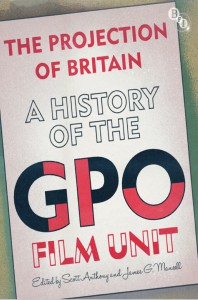The Projection of Britain: A History of the GPO, edited Scott Anthony and James G. Mansell (BFI Palgrave Macmillan, 2011), 352 pages. ISBN: 978-1844573752 (handback), Price: £65; ISBN: 978-1844573745 (paperback), Price: £22.50
 About the Author: Dr Dafydd Sills-Jones is Lecturer in Media Production at Aberystwyth University. Recent articles include ‘History on UK TV: The Rise of Reconstruction’ in Docu-fictions: Staging and Representing the Real (UVK, 2012) and contributions to Directory of World Cinema: Britain (Intellect, 2012).
About the Author: Dr Dafydd Sills-Jones is Lecturer in Media Production at Aberystwyth University. Recent articles include ‘History on UK TV: The Rise of Reconstruction’ in Docu-fictions: Staging and Representing the Real (UVK, 2012) and contributions to Directory of World Cinema: Britain (Intellect, 2012).
At first glance, the GPO Film Unit can seem dense, disparate and incoherent as an object of study. John Grierson was the leading light, but he didn’t direct much. Humphrey Jennings is revered, but seems atypical of the period. Soundtracks are often strange and hard to decipher. Many of the films seem hopelessly patronising, mixing process-driven narratives with grand social aspirations.
One can forgive the uninitiated these impressions when confronting the work of the GPO Film Unit. Penetrating under the surface of such impressions involves the negotiation of a growing, but nebulous literature. There are the classic articles by Grierson, the books by Hardy, Rotha and Watt, the studies by Aitken, and chapters by Barsam, Barnouw, Corner, Ellis & Mclain, and Winston, to name but a few. Yet, despite this difficult navigation, the works are often cited as an aesthetic unit, keystones of British film culture, and fundamental to the development of contemporary documentary.
This volume’s main function is to provide a map for this difficult navigation, and it achieves this by applying a number of strategies to the task.
 The book is divided into a structure of short chapters, which in turn are divided into seven coherent sections. These sections follow a narrative path through the analysis of the GPO film unit, beginning with the concepts in play, going on to case studies of filmmakers’ careers, then a discussion of aesthetics across the unit’s output, followed by a section on key films, all supported by collections of historical documents and useful appendices. This structure works very effectively for the reader when proceeding continuously from the beginning of the book to the end. Each section invites the reader to wonder at a new aspect of the GPO Film Unit’s history, and then these questions are either answered or deepened by the following sections. This structure also allows the reader to dip in and out; many of the chapters make excellent teaching resources. This book is therefore an excellent primer, at undergraduate and postgraduate level, for the GPO Film Unit’s history.
The book is divided into a structure of short chapters, which in turn are divided into seven coherent sections. These sections follow a narrative path through the analysis of the GPO film unit, beginning with the concepts in play, going on to case studies of filmmakers’ careers, then a discussion of aesthetics across the unit’s output, followed by a section on key films, all supported by collections of historical documents and useful appendices. This structure works very effectively for the reader when proceeding continuously from the beginning of the book to the end. Each section invites the reader to wonder at a new aspect of the GPO Film Unit’s history, and then these questions are either answered or deepened by the following sections. This structure also allows the reader to dip in and out; many of the chapters make excellent teaching resources. This book is therefore an excellent primer, at undergraduate and postgraduate level, for the GPO Film Unit’s history.
This structure is complemented by the variety of voices represented in the line-up of authors. There are BFI curators and film scholars of course, but there are also experts in cultural geography, graphic design and documentary editing. There are contributions from a PhD student, the head of British Telecom’s heritage department, and Sir Christopher Frayling. The diversity of author and background creates a vibrant portrait of the far reaching cultural significance of the GPO Film Unit at the time, from its position as avant garde nursery to partner in the state-sponsored promotion of a techno-corporate culture. The book therefore also operates as an introduction to a number of fields through which the GPO Film Unit can be further researched.
The book ends with a satirical piece by the anonymous blogger Roy Mayall, giving a personal perspective on how the mail service has changed in Britain over the past eight decades. The tone of the writing here is indicative of that used throughout. There a is a charm and lightness of touch in much of the writing that bears a similarity to the editor’s excellent monograph on the GPO Film Unit’s Night Mail (1936), and makes the reader’s work of assembling the differing layers of discussion and analysis that much more pleasurable.
The ingredients that hold this all together, and makes this book spectacularly attractive for tutors, are the sections containing reproduced historical documents. Part three of the book is practically a course reader, with contributions from Hardy, Reiniger, Sussex, Wright and Watt. The reproduced posters and photographs are invaluable in fleshing out the context of where these films were viewed, by whom and for what uses. Reproduced letters - such as Jennings’ invoice for clothes ruined whilst filming Silent Village (1943) or Grierson’s quietly powerful resignation letter - evoke the differing personalities of what was a colourful, chaotic, productive and highly significant organisation.
Dr Dafydd Sills-Jones